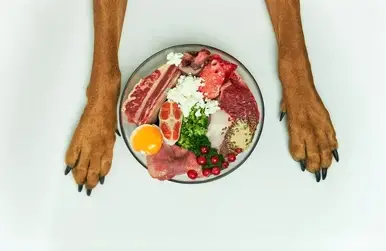If you’re thinking of starting a healthy, nutritious diet plan or raw diet for your dogs, giving them heart as a treat or a part of a raw diet is a great idea. But it matters when you don’t know how much heart to feed dog.
Indeed, hearts are a great source of protein, vitamins, and minerals to promote the overall health of your dogs. But you should maintain an adequate amount of heart feeding. Otherwise, giving excess heart can cause health issues to your dog.
This is only the tip of the iceberg. To ensure a healthy balance for feeding the heart, you must go through our detailed discussion. So without delay, Let’s get started!
What Types Of Hearts Can You Feed Your Dog?
Before we discuss in detail how much heart you feed the dog, first learn what types of heart you can feed them. If you’re just a beginner, this will help you to pick the right diet.
There are several types of hearts you can feed your dogs, such as Lamb heart, Ox heart, chicken heart, or beef heart. However, all types of hearts have some similarities in nutrition and are also great alternatives for each other. If you’re newly trying a raw diet for your dog, see below, where we overview varieties of hearts that are great for your dogs.
1. Lamb Heart
A Lamb’s heart is the heart of a lamb. You can find it in any butcher nearby or any super shop. The heart comes in various forms, like whole and raw or freeze-dried cubes. However, buying them from a butcher ensures the lamb heart is fresh and organic while ensuring your dog’s healthy nutrition.
Overall Nutritional Value
Lamb’s hearts contain rich vitamins, including A, C, and B complexes, and many minerals that promote a dog’s healthy organ, excellent immunity, (Here you can make an internal link on can you build up an immunity to dog allergies) and ensure optimal brain function. Additionally, its rich protein source efficiently helps muscle growth.
2. Ox Heart
If a lamb heart is unavailable near you, an ox heart will work the same as a lamb heart. As it sounds, an ox heart is the heart of an Ox. You can check out your local butcher shop to collect an ox heart, and you might want to cut up the heart into chunks.
It’s easy to break into small pieces and usable as the best training treat. On the other hand, a jerky-style ox heart can distract your dog’s concentration when you want to keep them busy for a short while.
Overall Nutritional Value
However, an ox heart is also a great item to ensure healthy nutrition for your dog. It contains high protein, lots of vitamins, minerals, and other elements that help to boost your dog’s immunity and metabolism.
3. Beef Heart
Doesn’t your dog like to eat lamb/ox heart? No problem, a beef heart can be another option to offer it a great heart treat. Moreover, the fresh beef heart is also easy to collect from the nearest butcher shop. On top of that, it is easy to chew, digest.
Overall Nutritional Value
Beef heart is also a great source of vitamins and minerals. It’s also an excellent source of iron, zinc, essential fatty acids, and vitamin B2, B3, B12 that help your dog’s coat be silky and smooth.
4. Chicken Heart
The chicken heart is the most accessible meat organ to feed your dog. Though most people don’t like its taste and consider it offal, your dog will love it very much. Although one chicken heart is enough for small dogs, the size might be a little small for large dogs.
Overall Nutritional Value
This small heart is full of nutrition. You can either feed this chicken heart by cooking, raw or freeze-dried. The taste will be magical for your dog, no matter how you prepare it. Chicken hearts contain taurine that’s very much nutritious for your pet.
How Much Heart To Feed A Dog?
The heart is organ meat. The veterinarian says that a dog should receive 2-3% of organ meat of its total body weight in its raw diet. It includes bone, muscle, and organs. But no single organ like a heart should eat more than 5% to 10% of the total organ meat quantity.
Lamb Heart
Despite lamb heart being a great healthy and nutritious source for your dogs, it contains rich fat and cholesterol up to 267 mg per portion. It’s an important thing to keep in mind while feeding.
Initially, how much lamb heart you should give the dog depends on whether you’re feeding it as a part of a raw diet or as a treat. If you’re feeding your dog a raw diet, you should not go up to 10% of its total organic meat.
However, if you feed dried lamb hearts, then a large cube will be enough to give an average-sized dog a few times a week as a treat.
Ox Heart
While feeding the ox heart to your dog, consider two things: what is the size of your dog and how you’re feeding the ox heart. Slowly introduce it to your dogs, and when you see the dog is used to it and no side effects have been raised, try it on the dog’s regular diet. If you’re following a raw diet, give your dog a piece of ox heart several times a week. Or offer it as a training treat daily.
Beef Heart
A whole beef heart generally weighs up to 10 pounds that has dark red, dense muscle meat surrounded by a layer of fat. So feeding overboard beef hearts can cause an unhealthy fat balance in the dog’s diet. Plus, giving excess beef heart can cause stomach upset. So take it easy as a slow process.
If your dog is large, give it a large piece of beef heart 3-5 times a week or reward it highly.
Chicken Heart
Chicken hearts also can be given to your pet’s daily diet or as dog treats. According to the veterinarian, you should feed chicken hearts below 5% of the dog’s daily raw diet. As Chicken heart contains rich vitamin A, if the dog receives more than this percentage, there could be a high chance of dealing with your pet’s loose and runny stool.
You can give a whole chicken heart at least three times a week or in small pieces daily.
What Happens If Your Dog Feeds Too Much Heart?
Typically, feeding too much heat can cause stomach upset like diarrhea. best dog food for german shepherd with diarrhea Otherwise, if your dog has any health issues previously, feeding too much heart can lead to major trouble.
When Should You Not Feed Heart To Your Dog?
Though hearts consider nutritious food for your dog, there are some exceptions too. In some cases, feeding the heart to your dog is not a great idea.
For lamb or ox heart, they are rich in fats, so if your dog has any fat-triggered conditions, such as pancreatic, inflammatory bowel disease, or exocrine pancreatic insufficiency, you should not give heart to your dog or give in a very small amount.
FAQs
How to prepare chicken hearts for dogs?
You can prepare chicken hearts for your dog in several ways. Fry the hearts in a little oil until they become light golden brown, or you can boil them. Otherwise, dehydrating chicken hearts are also a good option to prepare. However, you can try each recipe and check which one your dog likes to taste.
Though most veterinarians think that raw chicken heart is more natural and consists of more nutrition than cooked one.
How do you cook a beef heart for a dog?
Cook the beef heart in lightly salted water for 90 minutes. You need to change the water after every 30 minutes of cooking.
Is the liver too rich for a dog?
No, livers are rich in vitamins and proteins that are absolutely safe for dogs to eat. The liver’s minerals and vitamins help clean the blood toxins and support healthy vision.
Conclusion
So that’s all the answer to your question of how much heart to feed a dog. Hopefully, you have some ideas on how much heart you will give your dog next time. However, if you’re a beginner at a dog’s diet plan, we suggest consulting a veterinarian first.
If you have any queries, don’t hesitate to ask us in the comments below. We’ll try our best to help you with your dog’s grooming.
Good luck!

